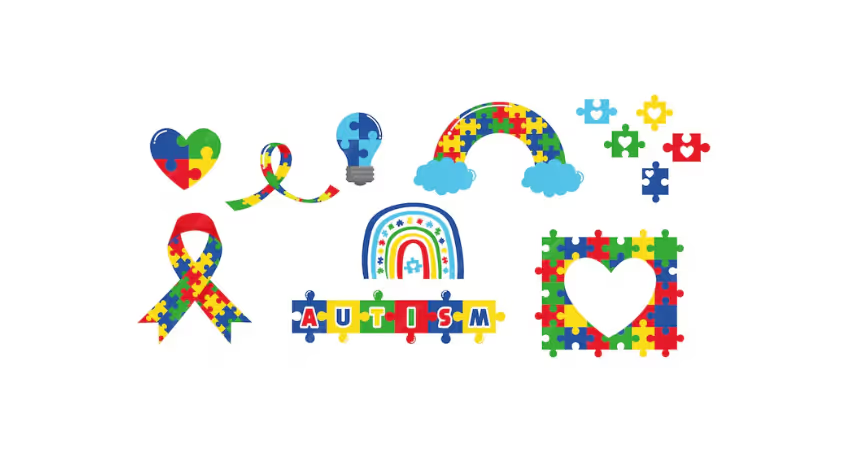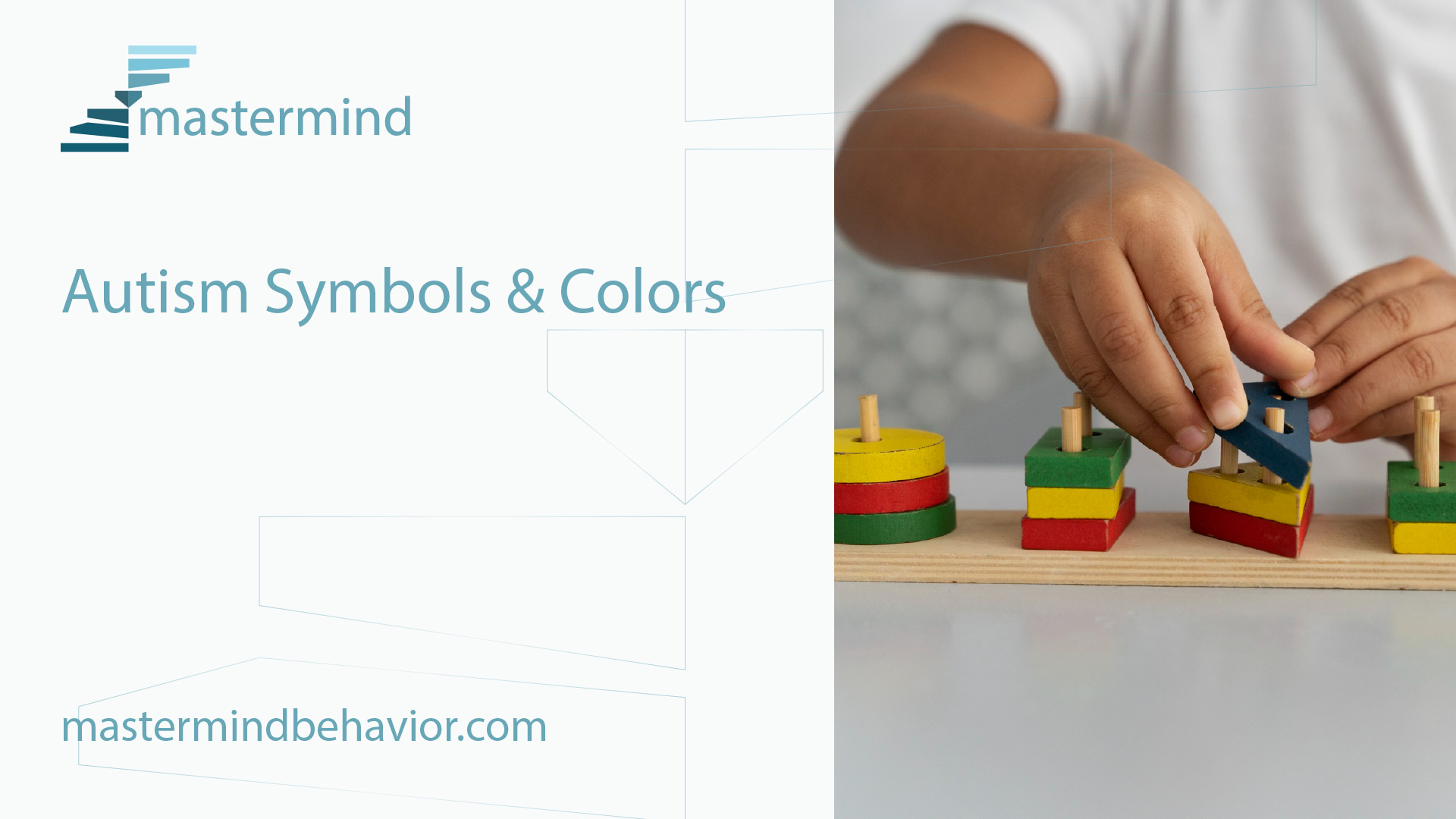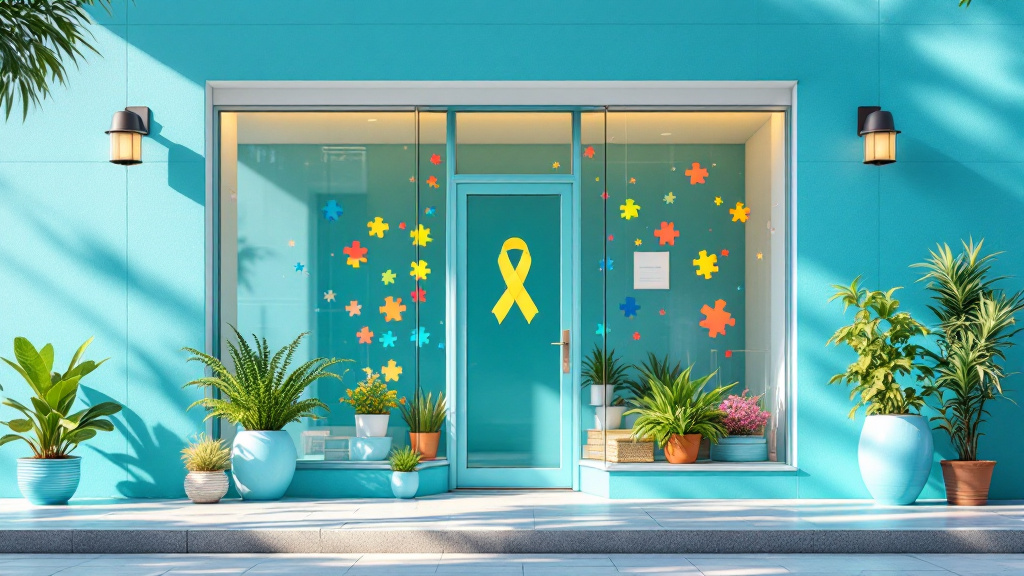Autism Symbols & Colors

Symbolism of Autism Awareness
In the realm of autism awareness, symbols and colors play an integral role in conveying the nuances of this complex condition. These symbols foster understanding, promote inclusion, and inspire support for individuals on the autism spectrum. Here we explore some of the most recognizable symbols associated with autism awareness.

Puzzle Ribbon Symbol
The puzzle ribbon is a potent symbol of autism awareness. This symbol is emblematic of the uniqueness and complexities associated with the autism spectrum. The interlocking, multi-colored puzzle pieces reflect the diversity of the people and families living with autism, while the bright colors signal hope – hope that through increased awareness, early intervention, and appropriate treatments, individuals with autism will lead fulfilling lives. The puzzle ribbon is a call to action, promoting inclusion and acceptance for those affected by autism.
Blue Ribbon Symbol
While the blue ribbon is widely used to represent various causes, within the context of autism, it is often associated with Autism Speaks' "Light It Up Blue" campaign held annually on World Autism Awareness Day. The campaign encourages people to wear blue to show support for the autism community.
Pink Ribbon Symbol
The pink ribbon is traditionally associated with breast cancer awareness and support for nursing mothers. However, in the autism community, it can sometimes signify support for birth parents of children with autism, recognizing the unique challenges they face and the vital role they play in their children's lives [1].
Rainbow Ribbon Symbol
The rainbow ribbon, typically associated with LGBTQ+ pride and equality, can also symbolize the diversity within the autism community. Just as each hue in a rainbow retains its individuality yet contributes to the beauty of the whole, each person on the autism spectrum brings their unique strengths and challenges to the collective autism community.
Gold Ribbon Symbol
The gold ribbon is internationally recognized as a symbol for childhood cancer awareness. While not directly linked with autism, the gold ribbon can sometimes be seen in autism awareness contexts to represent the comorbidity of autism and certain medical conditions, such as neuroblastoma, a type of cancer that commonly affects children.
These symbols and their associated colors are not merely decorative. They hold deep meaning, serving as visual cues to stimulate conversations about autism, heighten awareness, and foster an environment of acceptance and understanding.
Read about: Exploring the Types of Autism
Evolution of Autism Symbols
Over the years, symbols associated with autism have evolved to reflect the changing understanding and acceptance of autism in society. From the blue ribbon initiative to multicolored ribbons and the acceptance of the gold ribbon, these symbols have played a crucial role in raising awareness and promoting acceptance of individuals on the autism spectrum.
Blue Ribbon Initiative
The use of the blue ribbon as a symbol for autism awareness became prominent in the early 2000s. This color was chosen to represent the prevalence of autism among boys, as the condition is diagnosed more frequently in boys than girls. The blue ribbon initiative was spearheaded by Autism Speaks, with the aim of increasing visibility and understanding of autism within communities.
Multicolored Ribbons
In recent years, the use of multicolored ribbons has gained popularity as a symbol of autism awareness. These ribbons incorporate colors like blue, red, yellow, and green. This array of colors is intended to symbolize the diversity and uniqueness of individuals on the autism spectrum, moving away from a single-color representation to a more inclusive symbol that reflects the spectrum of experiences and identities within the autism community [2].
Gold Ribbon Acceptance
The gold ribbon has recently gained prominence as the primary color for the autism ribbon. This shift in symbolism represents a movement towards autism acceptance. The gold color emphasizes the talents, abilities, and potential of individuals with autism. The adoption of the gold ribbon as a symbol of autism acceptance has been growing, resonating with those who prioritize acceptance and celebration of the diverse abilities and strengths of individuals on the autism spectrum. The gold ribbon represents neurodiversity, focusing on acceptance and celebrating the diversity within the autism community, highlighting the inherent value and worth of individuals with autism [2].
The evolution of autism symbols and colors reflects the changing perceptions and understanding of autism in society. These symbols serve as powerful tools for advocacy, raising awareness, and fostering acceptance of individuals on the autism spectrum. They remind us of the importance of recognizing and valuing the diversity and unique experiences of individuals with autism.
Contemporary Autism Symbols
In recent years, the autism community has seen the introduction of new symbols to represent the diversity and individuality of those on the spectrum. These symbols, including the butterfly and infinity signs, offer a fresh perspective and alternative to traditional autism symbols.
Butterfly Symbol
A notable contemporary symbol for autism is the butterfly. Introduced as an alternative to the puzzle piece, the butterfly represents change, diversity, and continued development. It symbolizes the beauty of a different perspective and the importance of ongoing growth, emphasizing that individuals with autism may develop differently but will continue to grow and hit their milestones.
The butterfly symbol has gained traction due to its positive and inclusive imagery. It acknowledges the diversity of individuals on the autism spectrum and celebrates the full lives and beauty of differences within the autistic community. Some advocates suggest using the butterfly symbol as a replacement for the puzzle piece symbol, which has attracted criticism over the years [3].
Ultimately, the butterfly symbolizes the continual evolution and development of individuals with autism, much like a butterfly emerging in its own time.
Infinity Symbol
The infinity symbol is another modern representation associated with the autism community. While not as widely recognized as the butterfly symbol, it carries a potent message. The infinity symbol, often depicted in rainbow colors to represent the diversity of the autism spectrum, embodies the notion of infinite possibilities and potential for individuals with autism.
The infinity symbol serves as a reminder that though every individual with autism is different, they all share infinite potential to learn, grow, and thrive. It aims to counteract any negative or limiting beliefs about autism, emphasizing instead the boundless capacities and strengths of those on the spectrum.
Personal Symbolism
As much as universal symbols like the butterfly and infinity sign can be empowering, it's essential to recognize the power of personal symbolism. Individuals on the autism spectrum, their families, and caregivers often find personal symbols that resonate with their experiences and perspectives.
These personal symbols can range from a favorite animal, a cherished object, or even a color that holds special significance. The essential thing is that these symbols reflect the individual's identity and their unique journey with autism.
In conclusion, contemporary autism symbols like the butterfly and infinity sign have brought fresh perspectives to autism representation, emphasizing growth, potential, and diversity. As we continue to evolve our understanding of autism, it's likely that our symbolic representation of it will continue to grow and change as well.
Impact of Colors on Autism Awareness
Colors play a significant role in autism awareness, with different hues carrying unique meanings and associations. This section explores the symbolism and impact of various colors, including blue, red, gold, and purple, in relation to autism.
Blue Color Association
Blue is a color strongly associated with autism. It is closely linked with autism awareness and used in significant campaigns such as Autism Speaks' "Light it Up Blue" campaign on World Autism Awareness Day, April 2nd. Its calming effects help individuals on the spectrum feel more relaxed and comfortable. It also features prominently in the puzzle piece in the autism awareness ribbon, frequently used in awareness campaigns and events.
The color blue represents support, understanding, and raising awareness for individuals with autism, symbolizing calmness and trust [7]. The popularity of the color blue for autism was largely due to the 'Light It Up Blue' movement started by Autism Speaks, despite facing significant backlash.
Red Color Representation
While blue is commonly associated with autism, red has emerged as an alternative color. Some individuals within the autism community have adopted red to distance themselves from the controversial connotations of blue, which some argue reinforces the stereotype that girls cannot be autistic. The color red can symbolize the strength, passion, and courage of people with autism and their families.
Gold Color Alternatives
Gold is another color associated with the autism community, often used in conjunction with the infinity symbol to represent the diversity and uniqueness of the autism spectrum. The gold color is seen as a symbol of value and acceptance, emphasizing the valuable contributions people with autism make to society.
Purple Color Symbolism
Purple is a color that has gained traction in autism awareness. It is often used to represent the diversity and individuality of people on the autism spectrum. While not as widely recognized as blue, purple offers an alternative for those seeking a different color to represent autism awareness.
The use of different colors in autism symbols and awareness campaigns reflects the diverse experiences and perspectives within the autism community. It also underscores the ongoing evolution of how society understands and represents autism.
Critique of Autism Symbolism
While symbols associated with autism, such as the puzzle piece and the color blue, have been widely recognized and used in raising awareness, these symbols have also been subjects of debate and critique among various stakeholders, including organizations, parents, and individuals with autism themselves.
Puzzle Piece Controversy
The puzzle piece, first used in 1963 by the National Autistic Society (NAS) in the United Kingdom, is one of the most recognizable symbols for autism. It was initially designed to symbolize the 'puzzling' nature of autism. Over time, it has been interpreted to represent the complexity and diversity of individuals with autism. Modern depictions of the puzzle piece are often completely blue or rainbow-colored [9].
However, the puzzle piece has received mixed reactions from various quarters. While some see it as a symbol of the complexity and uniqueness of individuals with autism, others feel it implies that people with autism are 'missing pieces' that do not fit into societal expectations [5]. This perspective has led to a reevaluation of the puzzle piece symbol and its implications.
Symbolic Preferences
The choice of symbols to represent autism is not universally agreed upon. Some individuals and organizations prefer symbols that highlight the individuality and diversity of people with autism, moving away from the puzzle piece. Others, however, continue to embrace the puzzle piece, viewing it as a symbol of the hope for understanding and acceptance.
These differing preferences highlight the importance of viewing autism through a lens of diversity and individuality, rather than as a 'puzzle' to be solved. This perspective underscores the importance of fostering a society that recognizes and embraces the unique qualities that individuals with autism bring.
Organizational Influence
Organizations play a significant role in shaping the symbolism associated with autism. For instance, Autism Speaks popularized the puzzle piece and the color blue, which are now recognized globally as symbols for autism.
However, the influence of organizations is not without contention. Some argue that organizations should work in collaboration with individuals with autism to choose symbols that accurately represent their experiences and perspectives. This approach promotes inclusivity and ensures that the symbols used to represent autism resonate with the very individuals they aim to support.
In conclusion, while symbols like the puzzle piece and the color blue have played a crucial role in raising autism awareness, it's essential to continually reassess these symbols to ensure they accurately and respectfully represent individuals with autism. This process necessitates the active involvement of individuals with autism, their families, and organizations working in the autism field.
Future of Autism Representation
In the evolving landscape of autism representation, the future holds promising changes for the autism community. This includes ongoing awareness campaigns, increasing symbolic diversity, and wider adoption of new symbols.
Awareness Campaigns
Awareness campaigns are integral to promoting understanding and acceptance of individuals with autism. These initiatives aim to educate the public about autism, dispel misconceptions, and highlight the potential and abilities of individuals on the autism spectrum. A prominent example is the puzzle ribbon, a symbol that represents the uniqueness and complexities associated with the autism spectrum. Expect to see more creative and inclusive campaigns in the future that embrace the diversity of the autism community.
Symbolic Diversity
The future of autism representation also includes a broader range of symbols that encompass the varied experiences of individuals with autism. For instance, the butterfly symbol is a newer emblem for autism, representing change, diversity, and continued development. It symbolizes the beauty of a different perspective and the importance of ongoing growth [5].
Another alternative to the traditional puzzle piece is the infinity symbol, often paired with the rainbow spectrum. This symbol embodies the aspiration for inclusivity and integration into society for individuals on the autism spectrum. Additionally, it can represent a love of numbers, a common trait among autistic individuals [4].
Symbol Adoption
Adoption of new symbols is crucial to foster a more inclusive and understanding society. The gold ribbon, for instance, is gaining prominence as the primary color for the autism ribbon. It symbolizes a shift towards autism acceptance and emphasizes the talents, abilities, and potential of individuals with autism.
In the future, the adoption of these symbols could lead to a more comprehensive understanding of autism, encouraging people to look beyond the stereotypes and appreciate the unique strengths and abilities of individuals on the autism spectrum. It's clear that as our understanding of autism evolves, so too will the symbols and colors that represent this diverse community.
References
[1]: https://www.pulseuniform.com/coffee-time/awareness-ribbons-guide-colors-and-meanings/
[3]: https://www.autismparentingmagazine.com/autism-symbols/
[4]: https://www.angelsense.com/blog/what-do-the-autism-colors-and-symbols-mean/
[5]: https://theplaceforchildrenwithautism.com/autism-blog/autisms-colors-symbols
[7]: https://www.yellowbusaba.com/post/autism-symbols-colors
[8]: https://www.quora.com/What-is-the-reason-behind-the-colour-blue-being-used-for-autism-awareness-and-are-there-any-other-colours-that-can-be-used-to-represent-autism-instead
Recent articles

How to Encourage Cooperative Work and Play Among Children with ASD
Building Bridges: Fostering Social Cooperation in Children with ASD

How ABA Therapy Can Help with Task Completion and Focus
Unlocking Independence: The Role of ABA in Enhancing Focus and Task Skills

Understanding the Role of Social Skills Groups in Autism Treatment
Harnessing Social Skills Groups for Better Autism Support

The Importance of Visual Learning Tools in Autism Education
Enhancing Education Through Visual Supports for Autism

How Parent-Implemented Strategies Can Improve ABA Therapy Outcomes
Enhancing Autism Interventions Through Family Engagement

How to Support Advocacy Efforts for Autism Awareness and Acceptance
Championing Neurodiversity: Strategies and Resources for Autism Advocacy


